A factor that helped to drive record catastrophe bond issuance in 2014 was the structural changes which influenced a more sponsor friendly environment, according to the world’s largest reinsurance firm, Munich Re.
The German reinsurers latest Q4 insurance-linked securities (ILS) Market Update report from its Risk Trading unit, which we first covered in this article, highlights several key developments within the dynamics of catastrophe bond issuance, which it feels has created a “shift toward cedent-friendly structures.”
Since 2011, and more aggressively throughout 2014, the trigger type utilised by cat bond sponsors has made a significant shift towards indemnity-based deals, and away from the once popular parametric trigger.
“The share of such transactions on total outstanding notional grew to 72%, expanding 16 percentage points, thereby diminishing the use of parametric triggers that were once preferred by cat bond investors,” Munich Re explained.
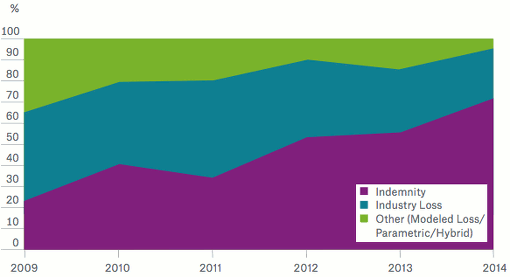
Catastrophe Bond Trigger Types (in % of Outstanding Capacity) - Source: Munich Re
Artemis has also documented the evolution of the catastrophe bond trigger over the years, with this chart showing how the use of the trigger types has changed from issuance year to year. As you can see, the indemnity trigger accounted for 70% of issuance in 2014, the highest level in over 15 years.
So, as over time the cat bond sponsor has opted against the basis risk inherent nature of a parametric deal, increasing their focus on indemnity triggers, the appeal and simplicity this provides for both returning and first time cat bond sponsors is evident. Munich Re describes this as a market environment that is “more reasonable for cedents.”
At the same time that cedents have learned to appreciate indemnity protection from cat bonds, as they are much simpler to fit into a reinsurance program that way, investors have also grown more sophisticated making it easier for them to assess the risks. This has also led to more unusual risks being included in indemnity deals and accepted by investors.
“The increased comfort of institutional investors in assessing non-standard indemnity risk was also demonstrated by the fact that indemnity triggers were used evenly by repeat and first-time issuers,” concludes the report.
As well as the trigger shift Munich Re’s ILS report notes that the recent market environment has seen cedents “lock in cover for a longer duration,” revealing an Average Risk Period (ARP) increase to 3.60 in 2014.
The ARP in 2013 was roughly 3.30 and in 2012 it settled at around 3.00, signalling that investors and cedents in the space are becoming more comfortable with cat bonds diversifying their portfolios over a longer risk period. It also demonstrates the appetite among some cedents to lock in the very attractive rates that a cat bond increasingly offers to them.
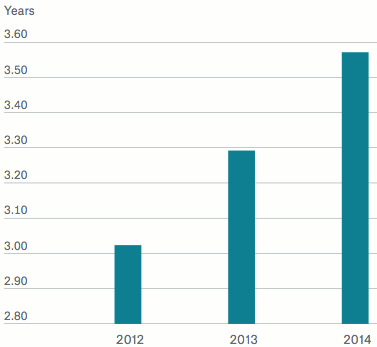
The growth of the average risk period of catastrophe bonds issued by year - Source: Munich Re
Aggregate protection also took a more dominant share of the market during 2014, revealing that the ILS market is increasingly willing to take on this type of coverage and further narrowing the gap between cat bonds and traditional reinsurance cover.
Aggregate coverage featured in a growing share of the cat bond deals issued last year, growing to 40% of total issuance volume in 2014, with the majority of this coming from the U.S. wind or hurricane peril.
Munich Re expects aggregate cover to be utilised further in the coming months, as the ILS investor base shows a willingness to take on this type of risk and increasingly mirrors the coverage provided by traditional or collateralized reinsurance.
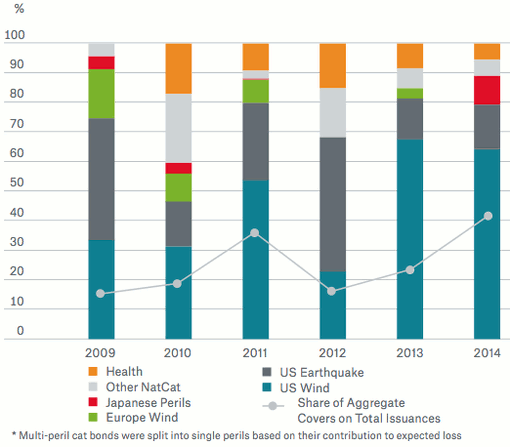
Share of Aggregate Covers on Total Issuances & Issuance Volume Split into Perils of Aggregate Catastrophe Bonds only* - Source: Munich Re
The expansion of aggregate covers again reveals a growing acceptance of cat bonds as a viable option for cedents seeking reinsurance or risk transfer protection. Combined with longer deal durations and the rise of the indemnity trigger, cat bonds become a much more comparable reinsurance buy, making them more attractive to cedents and easier to manage within a reinsurance tower.
Munich Re explains that; “The downside of long durations used to be the challenge in managing the cat bond within the overall reinsurance program, while reflecting portfolio growth and shrinkage.”
With this in mind, and likely another reason for the push towards aggregate coverage, is a shift in market standards towards a greater use of variable resets, which hiked to 30% in 2014. These features allow the cat bond to be actively managed within the reinsurance program, providing the ability to move the coverage up or down the tower.
As the image below shows, Q2 2014 was a particularly popular period for the use of variable resets in new cat bond issues.
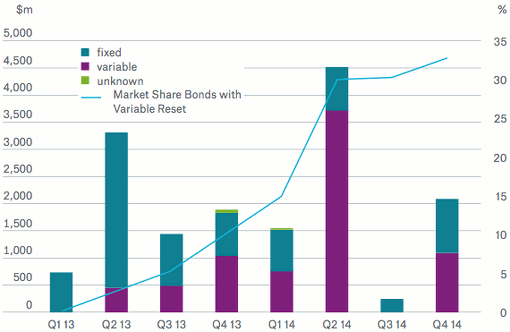
Catastrophe Bond & ILS Issuance Volume Split into Variable and Fixed Reset - Source: Munich Re
The significant and rapid rise in catastrophe bond sponsors use of variable resets shows how these types of transactional features can offer greater flexibility to cedents, making them a far more attractive means of risk transfer.
The report explains that; “On average the variable resets allowed for expected loss increases of 40% and decreases of 30%, with some deals providing even more flexibility.”
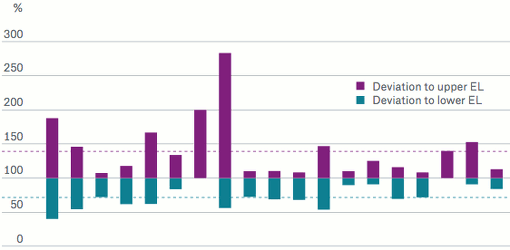
Expected Loss Range of Variable Reset ILS & Cat Bond Deals in 2014 - Source: Munich Re
As competition continues to expand in reinsurance, placing downward pressure on traditional reinsurance rates, the continued expansion of catastrophe bond coverage through more cedent-friendly structures ensures they remain attractive and viable alternatives.
Cedents are grateful for the much more flexible, friendly and appealing dynamics cat bonds offered through 2014, while for investors they are increasingly understood and accepted. Further shifts to support cedent needs are expected in 2015, as catastrophe bonds become a growing fixture in the reinsurance market.
Also read our first article covering Munich Re’s latest ILS market report:
– Growth shows ILS’ increasing acceptance as alternative asset: Munich Re.
 View all of our Artemis Live video interviews and subscribe to our podcast.
View all of our Artemis Live video interviews and subscribe to our podcast.
All of our Artemis Live insurance-linked securities (ILS), catastrophe bonds and reinsurance video content and video interviews can be accessed online.
Our Artemis Live podcast can be subscribed to using the typical podcast services providers, including Apple, Google, Spotify and more.































